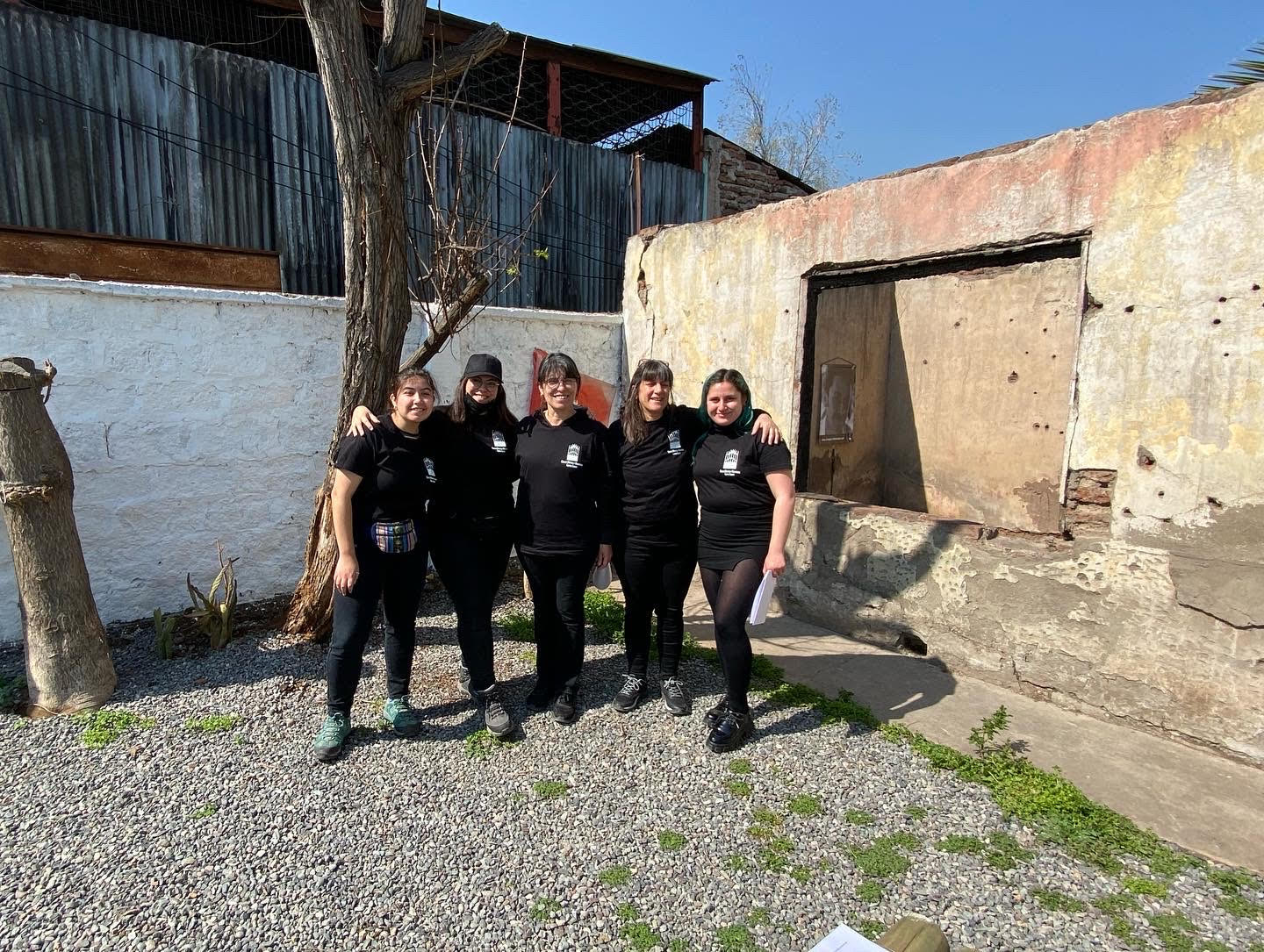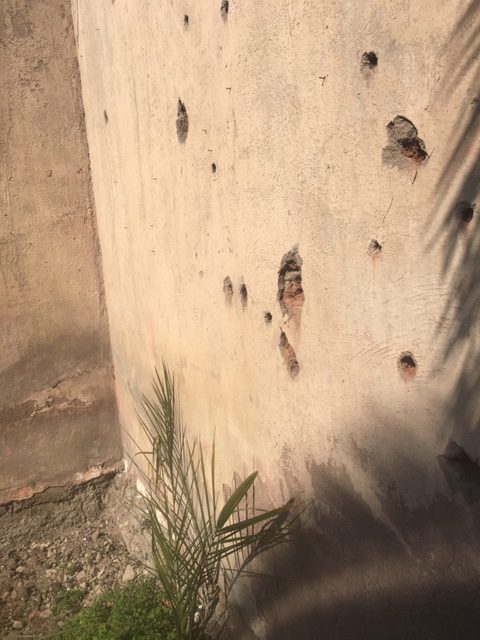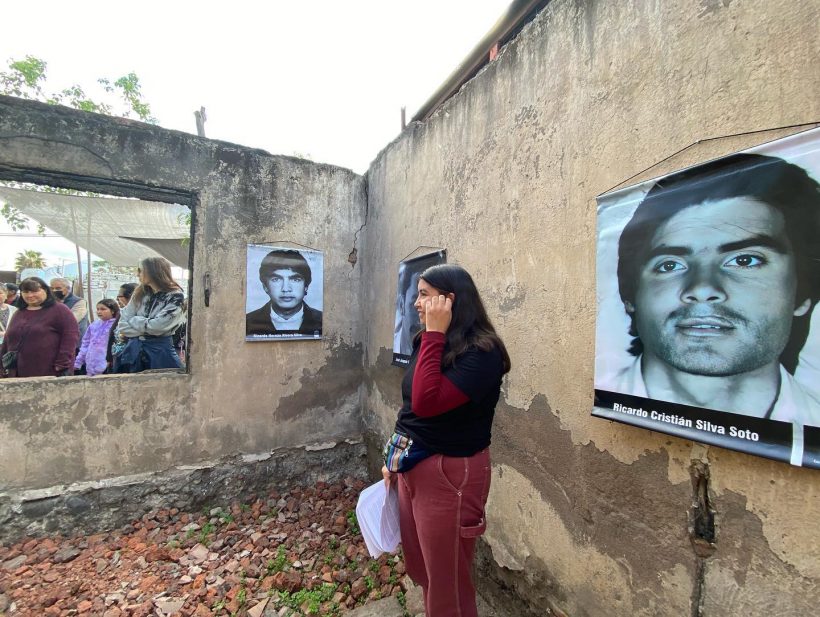By Maxine Lowy
An abandoned house and the story contained within its few standing walls are the driving force that propels a group of young people to create a new site of memory in north Santiago, in an era when negationism is on the rise in Chile.
The house always intrigued her. Every morning, walking at a fast clip to Recoleta Avenue on the way to school, and then with a more relaxed pace back home in the afternoons, she passed the place. Sometimes she would stop in front of the gate to peer through the wrought iron grid with the number 582A of that Pedro Donoso Street. Inside, she could see a house surrounded by a jungle of bushes, weeds and overgrown trees.
Long before her birth, something happened in this house that marked the neighborhood, and that even today, makes her mother Ana María González, 52, shudder.
In contrast to the adjacent neighborhood, Quinta Bella, where police raids and mass arrests sowed terror in its alleys following the military coup, along the wider streets of Población Venezuela, where she still lives, military presence had not been felt. In those days Pedro Donoso Street still had a tree-lined park in the middle stretching the two kilometers between Recoleta and El Salto avenues, with small hills where people cooled off in the grass on hot summer days.
The house was well-known in this neighborhood of north Santiago (at the time Conchalí; today Recoleta) because the family that lived there had a culture of solidarity. In the early 1980s, when the dictatorship’s harsh economic policies made neighbors’ lives precarious, community kitchens were organized there, and sometimes bingos to benefit people in need. They also opened their doors to meetings of the resistance. Military intelligence chose the place for its objectives in June 1987 because it was well-aware that members of the Frente Patriótico Manuel Rodríguez (FPMR) met there.
“On that day of June 16, 1987 I heard and I saw,” recalls Ana María, at the time a 17-year old high school student. What she heard awakened her before dawn. It was the sound of submachine gun fire.
Neighbors closer to the house could plainly hear an officer shouting through a megaphone: “You are surrounded! Give yourselves up!” And then silence.
Scores of officers, some in police uniform, others in plainclothes, and many police vans, cordoned off the area. Early on, reporters came to take a look and take photographs of the scene.
That day and in subsequent weeks the communications media reported on a gun battle with a band of dangerous extremists who had been shot down in the crossfire. Some out of fear of reprisals, others out of complicity, the major media repeated the oficial press release issued by the military dictatorship’s Natonal Communications Office (DINACOS) and the repressive Central Nacional de Informaciones (CNI).
Like her neighbors, Ana María was incredulous as she listened to the news reports. No nearby house had been struck by bullets; no bullets had been found on the street outside the house. Years laters, passing with her small daughter, Ana María would tell her that a hoax had been staged in that place, which the girl did not understand.
Today the girl, Misky Alvarez, is 26 years old, and the address 582 Pedro Donoso Street has become central for her: she is the secretary of the Corpus Christi House of Memory and Resistance Foundation that was created to restore the site and reclaim its history. Today Misky understands clearly what happened there.
Nine months after the failed attempt against the life of Augusto Pinochet, carried out by the FPMR on September 7, 1986 in the Cajón del Maipo canyon south of Santiago, in which five of his bodyguards died, the military intelligence apparatus was on the trail of the assaillants. Since early 1987 it had placed members of the FPMR under surveillance.
Before dawn on June 16, 1987, four men and three women, young members of the FPMR who had been detained at different locations the day before and tortured at the Cuartel Borgoña, near the northern banks of the Mapocho River in Santiago – blindfolded, hands tied, and barefoot- were put in vehicles that set off for Recoleta. Once there, the four men were placed in the front room, and the women in a back room, in the hallway and in the kitchen, all with two agents beside them. Upon a signal, the agents simultaneously shot the young people. But the theatricality did not end there: high calibre arms were placed around the victims. So culminated the final scene of what has come to be known as Operation Corpus Christi, the cold-blooded killing of twelve people. Not until the year 2007, when the Supreme Court’s definitive ruling corroborated the facts of the case, did the nation learn the truth: it had been staged to conceal a massacre.
Guides belonging to the Corpus Christi Memory and Resistance Assembly recount to visitors the life stories of the seven: At 20 years of age, the electromechanic and follower of liberation theology, Manuel Valencia Calderón, was the youngest. Ricardo Silva Soto, at 27, was a pharmaceutical chemistry student, a musician, and excelled at sports. Ricardo Rivera Silva, 24, a public transportation driver, had been a youth leader in the coal mining town of Lota, and loved swimming in the cold waters of the Pacific Ocean. Patricia Quiroz Nilo, 29, was known for her calm bearing, level-headedness, which made many trust in her leadership. From the time she was a child, Elizabeth Escobar, 29, experienced hardship due to her family’s limited economic means, that precluded her dream to study at a university. Esther Cabrera, 22, lovingly known as Chichi, was an outstanding, and charismatic high school leader. José Joaquín Valenzuela Levi, 30, an economist with artistic inclinations, had been commander of the attack in the Cajón del Maipo.
Misky and her friends of the Assembly belong to a new generation that grew up after the military dictatorship had officially ended but its legacy touched their lives in many ways. They identify with the seven young people who grew up in dictatorship as witnesses to the normalization of state terror and the precarization of people’s lives, which galvanized in them a process of awakening regarding injustice and the decision to actively oppose the regime through all means.
The young people of the milennium observe around them “egoism spawned by this neoliberal economic system,” that is expressed in an exacerbated materialism and individualism, notes Miguel Catalán, Foundation president. “Many kids become contaminated with resentment towards all things associated with the system, [and] end up isolating themselves.”
Silvana Núñez, vice president of the Foundation, says, “In Chile today poverty is different than that of the 1980s; it’s much more disguised, not always in plain view. There are better material conditions but I’m not sure how much things have really changed. Anyone who strives for a better life is on their own, has to make a personal effort, because the system is not there for them.”

Fundación de Casa Pedro Donoso
“From there,” Miguel explains, “arose the idea of recovering this site of memory to transform it into a place for sharing new ideas and supporting local organizations that want to positively shape the reality that affects them. Create a space of resistance in the northern zone of Santiago.” Misky adds, “We want to generate a space where empathy can flow. To think about the other. It’s quite basic.”
The once enigmatic gate now frequently opens to the neighborhood. Assembly members give guided visits and have held many cultural activities. In October a book was launched there and art and photographs exhibits were mounted on the premises. An artist called Nicolás hung his pyro-engravings in what had been the front room, its wall peppered with bullet holes. He was born 5 years after the episode that was staged here and lives nearby. He passed through the gate for the first time earlier this year. “What these kids have done is simply fantastic. They have breathed new life into this space but without intervening its history. It’s important not to alter our history in this space where history is so palpable. Every time I enter here, I feel a special energy.”
Juan, a Spaniard who attends university in Santiago and collaborates with the house restoration project, also was present for the cultural activity in October. “I experience it as something quite personal because my country endured a 40-year military dictatorship, and only recently have there been efforts to reclaim our history. In Spain, memory is mainly promoted by government institutions, whereas this project was generated from the grassroots. It is model for all of us and offers important lessons.”
Cultural events are posible today because since the beginning of 2022, twenty people have worked to clear, weed, and restore the site. Several truckloads of garbage and rubbish have been removed. During the seventh work session, in August, they installed water and sewage pipes, restored the bathroom, and removed tree roots. When they first rolled up their sleeves to tackle the cleanup, only the bare skeleton of the house was standing. Its roof, windows, doors and floors had been destroyed in bonfires or sold for cash by people who jumped the outer wall and occupied the house several years, as a place to get drunk and consume drugs.
Given the house’s vulnerability as well as the real estate developers who eye the property, which at two blocks from a subway station, has a high property. “It is urgent to take measures to preserve it and prevent further destruction,” Foundation members say.
A significant step in that direction was the unanimous vote by the Council of National Monuments (CNM), a government agency under the Education Ministry, that on November 23 approved the request to declare the house at 582A Pedro Donoso Street an historic heritage national monument. A key player that helped this come about was the Municipality of Recoleta and its Human Rights Observatory.
Of the 1132 places along the length of Chile that, in 2005, the National Commission on Political Imprisionment and Torture identified as having been used by the dictatorship to detain and torture people, less than 30 have been declared national monuments by the CNM. In January 1996, the Hornos (ovens) of Lonquen, former lime production kilns south of Santiago where, in 1978, the remains of 15 forcibly disappeared people were found, became the first declared Historic Monument. Later in 1996, Villa Grimaldi, where an estimated 4500 women and men (of whom 228 remain forcibly disappeared) were brought between 1974 and 1977, was the first site of memory to be recovered as such on the Latin American continent and received the status of Historic Monument in 2004.
When the declaration decree is published in Chile’s congressional record, the house at 582A Pedro Donoso Street will formally join the others in fortifying historical memory, educating about human rights, and providing moral reparation for the victims’ families.
A family member (who prefers not to be identified by name) close to the story of the house at 582A Pedro Donoso Street eloquently underscores its value as a site of memory. “This site is part of a geography of terror, of an imprint, a trace, a mapa that inscribes the full scope of the the human rights violations committed by the mililtary dictatorship,” she said. “It is different to read about something that happened at a certain place that you cannot anchor as an image in your memory and in your heart, than see it physically, concretely.”
“All sites of memory speak of horrors and are particularly meaningful because horror is something so indescribable that no words ever suffice to describe it,” she added. “Everything that a human being is incapable of saying, is said by a site of memory. These sites of conscience that extend on across the face of the earth, remind us that horror exists as a human possibililty. They also strengthen today’s struggles to prevent such things from happening again. But in the 35 years since this happened here, and ferocious human rights violations were committed once again. Therefore, the idea of “never again” has to been reedited continuouslly and must circulate as a concept among as many human beings as we can reach.”
In this day and age when negationism in Chile chips away at fragile memories, the walls at 582A Pedro Donoso Street don’t just talk, rather, they shout loud and clear.

Maxine Lowi










